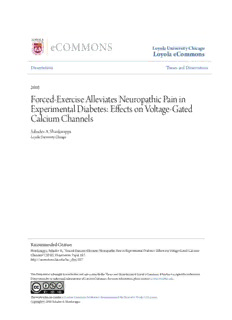
Forced-Exercise Alleviates Neuropathic Pain in Experimental PDF
Preview Forced-Exercise Alleviates Neuropathic Pain in Experimental
LLooyyoollaa UUnniivveerrssiittyy CChhiiccaaggoo LLooyyoollaa eeCCoommmmoonnss Dissertations Theses and Dissertations 2010 FFoorrcceedd--EExxeerrcciissee AAlllleevviiaatteess NNeeuurrooppaatthhiicc PPaaiinn iinn EExxppeerriimmeennttaall DDiiaabbeetteess:: EEffffeeccttss oonn VVoollttaaggee--GGaatteedd CCaallcciiuumm CChhaannnneellss Sahadev A. Shankarappa Loyola University Chicago Follow this and additional works at: https://ecommons.luc.edu/luc_diss Part of the Neuroscience and Neurobiology Commons RReeccoommmmeennddeedd CCiittaattiioonn Shankarappa, Sahadev A., "Forced-Exercise Alleviates Neuropathic Pain in Experimental Diabetes: Effects on Voltage-Gated Calcium Channels" (2010). Dissertations. 187. https://ecommons.luc.edu/luc_diss/187 This Dissertation is brought to you for free and open access by the Theses and Dissertations at Loyola eCommons. It has been accepted for inclusion in Dissertations by an authorized administrator of Loyola eCommons. For more information, please contact [email protected]. This work is licensed under a Creative Commons Attribution-Noncommercial-No Derivative Works 3.0 License. Copyright © 2010 Sahadev A. Shankarappa LOYOLA UNIVERSITY CHICAGO FORCED-EXERCISE ALLEVIATES NEUROPATHIC PAIN IN EXPERIMENTAL DIABETES: EFFECTS ON VOLTAGE-GATED CALCIUM CHANNELS A DISSERTATION SUBMITTED TO THE FACULTY OF THE GRADUATE SCHOOL IN CANDIDACY FOR THE DEGREE OF DOCTOR OF PHILOSOPHY PROGRAM IN NEUROSCIENCE BY SAHADEV A SHANKARAPPA CHICAGO, ILLINOIS MAY 2010 Copyright by SAHADEV SHANKARAPPA, 2010 All rights reserved ACKNOWLEDGEMENTS Firstly, I would like to acknowledge Dr. Evan B. Stubbs, Jr., who has been my graduate advisor, mentor, and racquetball teacher, for his guidance in helping me to understand, critically think, and do science in an organized and logical manner. I sincerely thank Dr. Erika S. Piedras-Rentería, who has been my second mentor, for all her help, suggestions, and guidance for the electrophysiology component of this dissertation. I also thank the members of my graduate committee, Dr. Edward J. Neafsey, Dr. Morris Fisher and Dr. Gwendolyn Kartje, for their valuable suggestions and encouragement. I acknowledge the Arthur J Schmitt foundation for awarding me the Schmitt fellowship, and the Veteran Affairs department of rehabilitation services for the financial assistance, that made this study possible. I would like to thank my colleagues, Dr. Jason Sarkey, Dr. Cynthia Von ee and Mr. Michael Richards, for their assistance, advice and encouragement during my graduate career. I thank my mother, Gowthami; my father, Shankar; and my sister, Parvathi; for their unrelenting emotional support throughout my career. I thank my wife Shivanee, and my daughter Aarika without whom I would not have come this far. iii “To my lovely wife Shivanee and my beautiful daughter Aarika TABLE OF CONTENTS ACKNOWLEDGEMENTS iii TABLE OF CONTENTS v LIST OF TABLES ix LIST OF FIGURES x LIST OF ABBREVIATIONS xii ABSTRACT xiv CHAPTER 1. INTRODUCTION 16 STATEMENT OF PROBLEM 16 HYPOTHESIS 19 SPECIFIC AIMS 19 LITERATURE REVIEW 21 DIABETES MELLITUS 21 Epidemiology of DM 23 Complications of DM 23 DIABETIC NEUROPATHY 25 Pathogenic mechanisms of diabetes-associated nerve injury 25 Neuropathic pain in diabetic neuropathy 28 Experimental animal models of diabetic neuropathy 29 Streptozotocin (STZ)-induced DM 30 STZ-induced diabetic polyneuropathy 32 v Treatment options in diabetic neuropathy 32 Exercise as a therapeutic strategy 33 Exercise and voltage-gated calcium channels 34 VOLTAGE GATED CALCIUM CHANNELS 36 High-voltage activated Ca2+ channel isoforms 39 Low-voltage activated Ca2+ channels 41 Role of voltage-gated Ca2+ channels in neuropathic pain 42 2. FORCED-EXERCISE ALLEVIATES NEUROPATHIC PAIN IN EXPERIMENTAL DIABETES: EFFECTS ON VOLTAGE-GATED CALCIUM CHANNELS 46 ABSTRACT 46 INTRODUCTION 48 MATERIALS AND METHODS 51 Animal care 51 Induction of experimental diabetes mellitus 51 Experimental exercise regimens 52 Tactile-responsiveness to Von-Frey filaments 53 Thermal responsiveness to infra-red heat stimulus 54 Peripheral nerve conduction studies 55 Dissociation of dorsal root ganglia neurons 57 Voltage clamp electrophysiology 57 Statistical analysis 59 vi RESULTS 60 Streptozotocin-induced diabetes and voluntary-exercise 60 Streptozotocin-induced diabetes and forced-exercise 60 Forced-exercise protects against STZ-induced diabetes-associated nerve conduction deficits 61 Forced-exercise delays onset of diabetes-associated hyperalgesia 62 Responsiveness to thermal stimulus is not altered by forced-exercise 63 Naloxone reverses forced-exercise induced analgesia 64 Forced-exercise prevents diabetes associated alteration in Ca2+ current densities 64 Diabetes-associated changes in LVA Ca2+ current steady-state inactivation 66 DISCUSSION 79 3. D-GLUCOSE DEPENDENT MODULATION OF Ca 3.2 α CHANNEL V 1H FUNCTION 85 ABSTRACT 85 INTRODUCTION 87 MATERIALS AND METHODS 89 Cell culture 89 Voltage Clamp Electrophysiology 89 Statistical Analysis 91 RESULTS 92 D-Glucose induced enhancement of T-type currents in HEK-293 cells 92 D-glucose induced alteration of Ca 3.2 channel gating properties 92 V Effect of D-glucose on Ca 3.2 channel steady state properties 93 V vii Aldose reductase inhibition does not alter D-glucose induced enhancement of Ca 3.2 currents 93 V DISCUSSION 104 SUMMARY 107 REFERENCES 111 VITA 132 viii LIST OF TABLES Table Page 1. Classification of Diabetes Mellitus 22 2. Clinical classification of glucose tolerance based on plasma glucose levels. 23 3. Types, symptoms, and signs of diabetic neuropathy. 26 4. Mechanisms of diabetes induced nerve injury. 28 5. Animal models of DM and its subtypes 30 6. Pharmacology and function of the α1 Ca2+ channel subunit. 37 7. Evoked compound muscle action potential response from the sciatic nerve of STZ-diabetic rats subjected to sedentary or forced-exercise. 71 8. Conduction velocity calculated from the tail nerve in diabetic rats subjected to forced-exercise. 72 9. Passive membrane properties of dissociated small diameter DRG neurons. 78 10. Comparison of in vitro and in vivo glucose concentrations. 95 11. Osmolarity measurements of normal and high-glucose containing media. ......... 95 ix
Description: